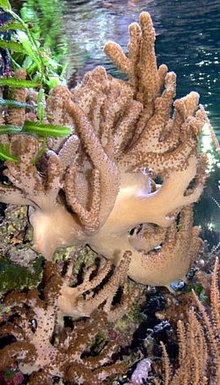
Back مرجانيات رخوة Arabic القونيه ARZ Alsionarilər Azerbaijani آلسیوناریلر AZB Alcionacis Catalan Alcyonacea CEB Weichkorallen German Alcyonacea Spanish مرجان نرم Persian Pehmytkorallit Finnish
| Soft coral | |
|---|---|

| |
| Cladiella sp. | |
| Scientific classification | |
| Domain: | Eukaryota |
| Kingdom: | Animalia |
| Phylum: | Cnidaria |
| Class: | Octocorallia |
| Order: | Alcyonacea Lamouroux, 1812 [1] |
| Suborders | |
|
See text | |
| Synonyms | |
| |
Alcyonacea are an order of sessile colonial cnidarians that are found throughout the oceans of the world, especially in the deep sea, polar waters, tropics and subtropics. Whilst not in a strict taxonomic sense, Alcyonacea are commonly known as soft corals. The term "soft coral" generally applies to organisms in the two orders Pennatulacea and Alcyonacea with their polyps embedded within a fleshy mass of coenenchymal tissue.[2] Consequently, the term "gorgonian coral" is commonly handed to multiple species in the order Alcyonacea that produce a mineralized skeletal axis (or axial-like layer) composed of calcite and the proteinaceous material gorgonin only and corresponds to only one of several families within the formally accepted taxon Gorgoniidae (Scleractinia). These can be found in order Malacalcyonacea (taxonomic synonyms of include (unnacepted): Alcyoniina, Holaxonia, Protoalcyonaria, Scleraxonia, and Stolonifera.[3] They are sessile colonial cnidarians that are found throughout the oceans of the world, especially in the deep sea, polar waters, tropics and subtropics. Common names for subsets of this order are sea fans and sea whips; others are similar to the sea pens of related order Pennatulacea. Individual tiny polyps form colonies that are normally erect, flattened, branching, and reminiscent of a fan. Others may be whiplike, bushy, or even encrusting.[4] A colony can be several feet high and across, but only a few inches thick. They may be brightly coloured, often purple, red, or yellow. Photosynthetic gorgonians can be successfully kept in captive aquaria.
About 500 different species of gorgonians are found in the oceans of the world, but they are particularly abundant in the shallow waters of the Western Atlantic, including Florida, Bermuda, and the West Indies.[5]
- ^ van Ofwegen, L. (2011). "Alcyonacea Lamouroux, 1812". WoRMS. World Register of Marine Species. Retrieved 15 December 2011.
- ^ Bayer, F. M. (1961). The shallow-water Octocorallia of the West Indian region. Studies on the Fauna of Curaçao and other Caribbean Islands, 12(1), 1-373.; Córdova-Isaza, A., Jiménez-Mármol, S., Guerra, Y., & Salas-Sarduy, E. (2023). Enzyme Inhibitors from Gorgonians and Soft Corals. Marine Drugs, 21(2), 104. https://doi.org/10.3390/md21020104; Raimundo, I., Silva, S., Costa, R., & Keller-Costa, T. (2018). Bioactive Secondary Metabolites from Octocoral-Associated Microbes—New Chances for Blue Growth. Marine Drugs, 16(12), 485. https://doi.org/10.3390/md16120485
- ^ Daly, M., M.R. Brugler, P. Cartwright, A.G. Collins, M.N. Dawson, D.G. Fautin, S.C. France, C.S. McFadden, D.M. Opresko, E. Rodriquez, S.L. Romano, J.L. Stake. (2007). The phylum Cnidaria: A review of phylogenetic patterns and diversity 300 years after Linnaeus. Zootaxa. (1668): 127–182., available online at http://www.mapress.com/zootaxa/2007f/zt01668p182.pdf; McFadden, C.S.; van Ofwegen, L.P.; Quattrini, A.M. (2022) Revisionary systematics of Octocorallia (Cnidaria: Anthozoa) guided by phylogenomics. Bulletin of the Society of Systematic Biologists. 1(3), 8735, pp. 1-79. Available online at https://ssbbulletin.org/index.php/bssb/article/view/8735 page(s): 21; Schoch CL, et al. NCBI Taxonomy: a comprehensive update on curation, resources and tools. Database (Oxford). 2020: baaa062. PubMed: 32761142 PMC: PMC7408187.
- ^ Borneman, Eric H. (2001). Aquarium Corals: Selection, Husbandry, and Natural History. Neptune City, NJ: T.F.H. Publications. p. 464. ISBN 1-890087-47-5.
- ^ "Sea Fan". University of Delaware Graduate College of Marine Studies. Archived from the original on 17 April 2006. Retrieved 23 September 2007.